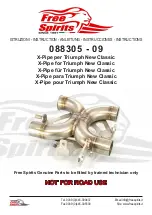
Doc ID: 191-7803A
Doc Rev: 011918
Pg. 19
·
If there is too much Free Play Gain, the installed gap
is too small.
The bike may drag and stall because it has
difficulty disengaging the clutch. It may also be difficult to
shift. Too much Free Play Gain will not hurt the clutch,
but it will negatively affect clutch performance.
·
If there is too little or no Free Play Gain, the installed
gap is too large.
This means when the EXP is fully
expanded it does not lift the pressure plate. The clutch
may slip and make the bike seem like it is losing power.
The bike may not move forward even though the engine
RPM increases as if the clutch lever is slightly pulled.
Too little Free Play Gain will cause the clutch system to
burn up.
Optimal Free Play Gain yields 1/8” (3 mm) of clutch lever
movement, measured at the ball end of the lever.
This
measurement at the lever correlates to achieving the ideal
installed gap.
The following steps explain
2 ways
to check Free Play Gain.
One way uses the rubber band Rekluse includes in the
clutch kit, and one uses your hand. You can use either
method to check for Free Play Gain.
Rekluse recommends that you begin with the rubber band
method first to check for Free Play Gain and then learn the
hand method. The rubber band will help you learn how to
recognize Free Play Gain until you are comfortable with the
hand method. Learning to check Free Play Gain by hand
effectively and comfortably can make it easy to check Free
Play Gain every time you ride.
Two Ways to Check for Free Play
Gain
















































